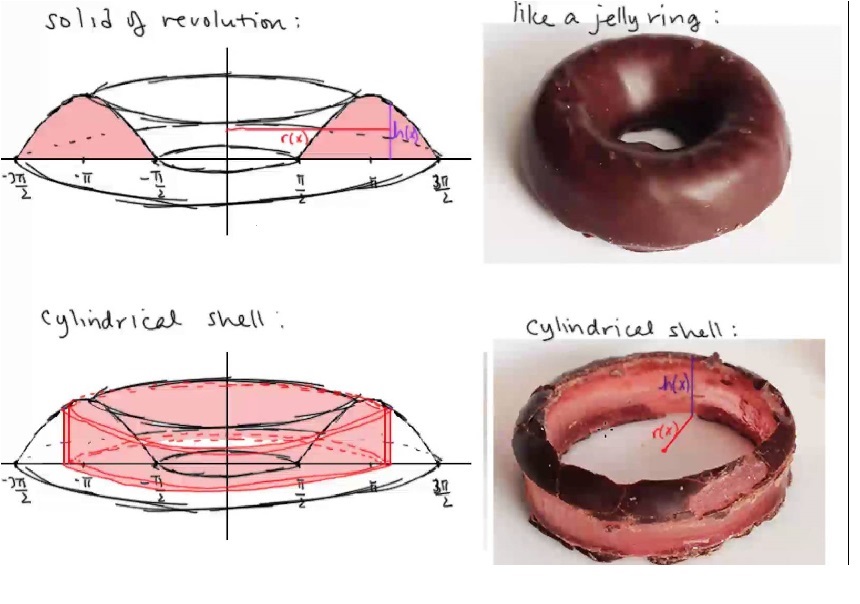
licensed under a Creative Commons Attribution-ShareAlike 4.0 International License.
Prerequisites:
Intro to Sage
Graphing and Solving Equations
Symbolic Integration
Volume, part 3: Cylindrical Shells
For some solids of revolution, the disk and washer methods we discussed last week are difficult, if not impossible. For these examples, there is another method: cylindrical shells.
Example 1
Find the volume of the solid obtained by rotating around the y-axis the region between and the x-axis from to .
Here is the region:
Here is the surface we get by rotating the curve. It's kind of like a bundt cake.
If we take cross sections perpendicular to the y-axis (the axis of rotation), we get annuli (or washers). But we run into problems with this method:
The inner and outer radii are given by the same function.
To find the limits of integration, we need to find the maximum y-value on this interval.
We need to know given ; that is, we must solve for .
For this particular example, we could solve these problems (but it would take some work). Let's try another approach, which turns out to be easier.
Instead of slicing with a horizontal knife (to get cross sections), let's cut this "cake" using cylindrical "cookie cutters". That is, take a cylinder of radius (centered on the axis of rotation) and press it straight through the solid. Then take a cylinder with a slightly bigger radius (say ) and press it down. What you have now cut out is a cylindrical shell, a slab of cake shaped like a circular cylinder.
Here's a sample picture I found online (it's from a YouTube video by Andrea Marchese of the City College of New York):

What's the volume of this cylinder of cake?
Slice the slab down the side and unroll it. What you have is a flat slab of cake. Its height is the height of the cake at that point , its width is the circumference of the cylinder , and its thickness is . I have the approximations because our cylindrical shell is not exactly flat on top (because of the curve of the function).
So the volume of this slab is approximately .
Now we need to keep cutting more slabs until we've cut up the whole cake, approximate the volume of each slab, and add them all up. That gives the approximate volume of the cake.
Of course, we make the approximation better by cutting thinner slabs. In other words, we let the number of cylindrical shells approach infinity.
Does this process sound familiar? It should; this is the limit of Riemann sums again - an integral!
Here's the final result:
The volume of the solid is .
In general, the volume of the solid obtained by rotating about the y-axis the region between a curve and the x-axis from to is given by
Example 2
Find the volume of the solid obtained by rotating around the y-axis the region between and the x-axis from to .
The volume is .
[Note: we could have done this with washers as well.]
Example 3 - Rotating around a vertical line other than the y-axis
Find the volume of the solid obtained by rotating around the line the region between and the x-axis from to .
Since we are rotating around the line and not the y-axis, the shell radius is not given by ; instead, the shell radius is . The shell height is given by the function, .
So the volume is .
Example 4 - Rotating around a horizontal line
Find the volume of the solid obtained by rotating around the x-axis the region between the curves and from to .
This could be done with washers, but let's try to use cylindrical shells. Here we are rotating around a horizontal line (the x-axis). That means our shell radius will be , and our shell height is the horizontal distance between the curves at that given .
We need to solve our equations for . For the first, we get . For the second, . The shell height is then .
Thus, the volume is .
[Note the limits of integration are y-values. When , then ; when , then .]
Example 5 - Two Functions with a Gap
Find the volume of the solid obtained by rotating around the x-axis the region between the curves and from to .
Here is a picture of the region. Notice the gap between the two functions.
When using cylindrical shells to find the volume, the shell radius will be given by , but the shell height is not as simple as the last problem. From to , the height is the distance from the y-axis to the curve (or ), and from to , the height is the distance from the curve (or ) to the vertical line .
This means we need two different integrals, to cover the two cases.